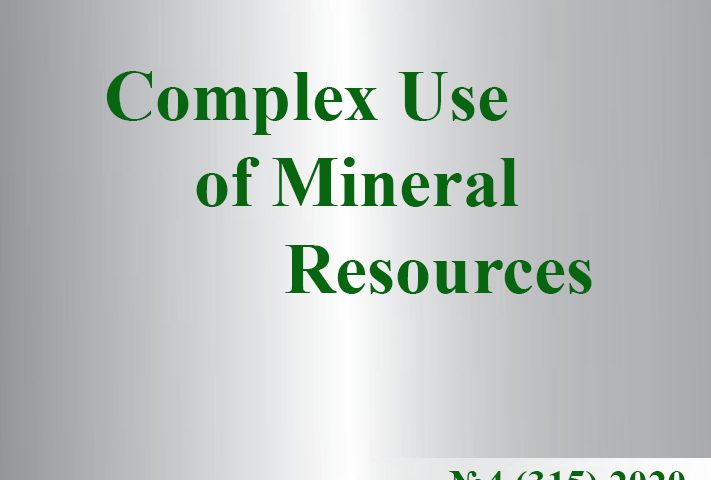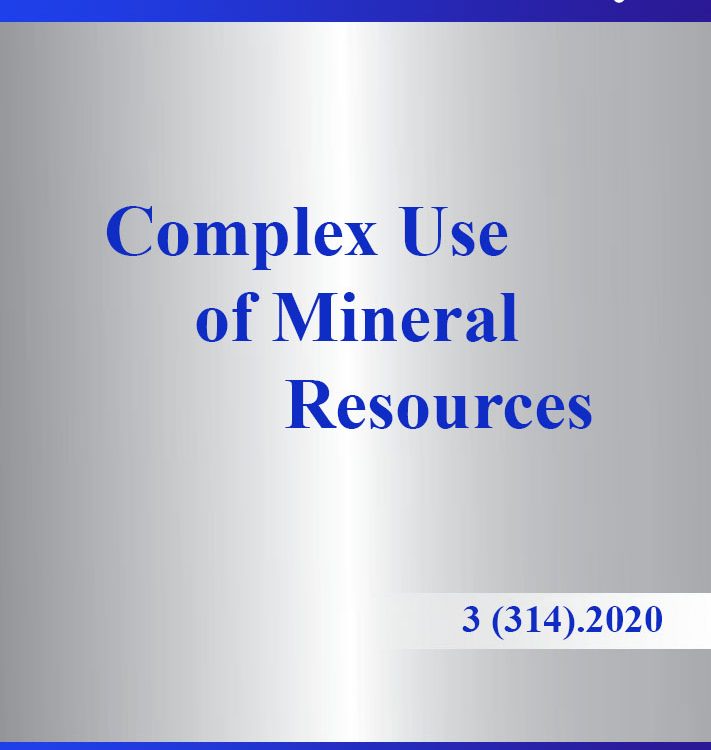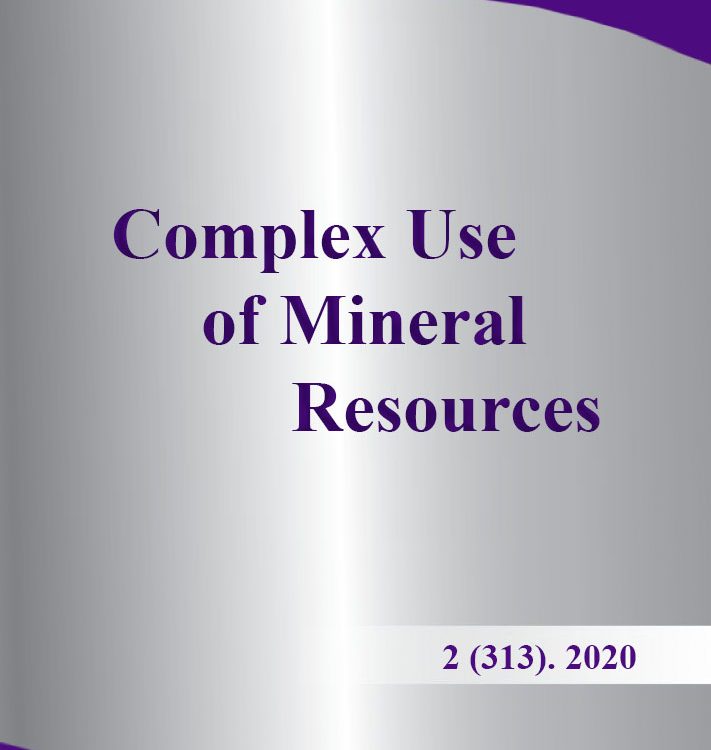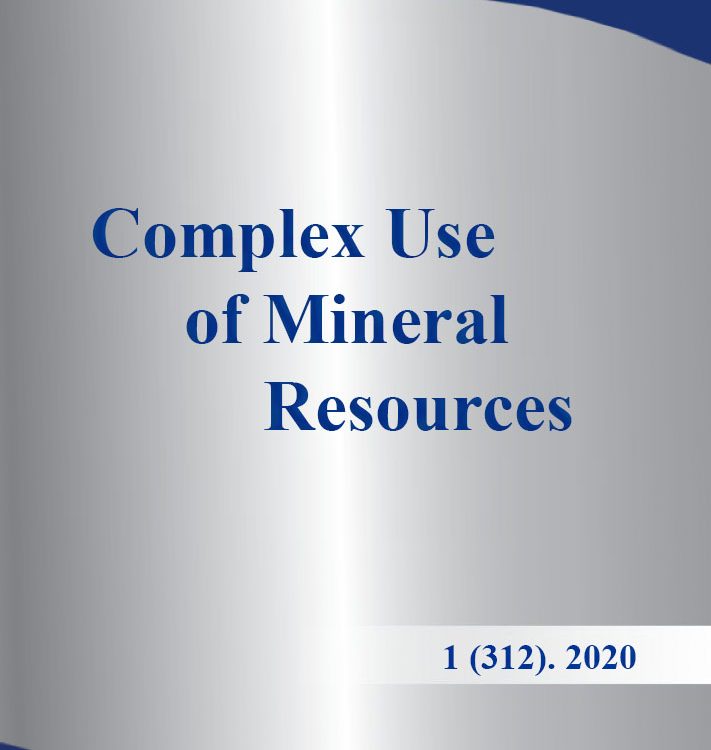Title: Study of leaching processes of sintered black shale ore
Authors: Khabiyev A. T., Baigenzhenov O. S., Yulussov S. B., Akbarov M. S., Sydykanov M. M.
Abstract: This paper presents the results of physical and chemical investigation of black shale ore, as well as the investigation of combination of hydro- and pyrometallurgical methods in the sintering process of black shale ore with ammonium hydrosulfate to convert metals into water-soluble form. The homogeneous composite of black shale ore taken for the study consists of 67 % SiO2, 18 % C and 3 % H2O, 0.683 % V, 0.0415 Mo, 0.0148 % U3O8 and other components. Thermogravimetric analysis of sintering of carbon-silica ore with ammonium hydrosulfate in the presence of sulfuric acid was performed in the temperature range 20-1000 °C. It is established that at low-temperature sintering of ore with hydrosulfate ammonium after further leaching with sulfuric acid solution the extraction of uranium, vanadium, molybdenum and rare earth metals is 98.2 %, 91.3 %, 82.2% and 78.3 % respectively. The optimal leaching temperature is 90 °C, the ratio S: L = 1:3, and the leaching time is 2 hours.
Title: Obtaining selenium concentrate from the slime of the sulfuric acid workshop of the Balkhash copper plant and extracting selenium from it into solution
Authors: Zagorodnyaya A. N., Sharipova A. S., Linnik X. A., Ruzakhunova G. S.
Abstract: The article presents the results of large-scale laboratory tests of obtaining selenium concentrate from the slime of the sulfuric acid workshop (hereinafter: slime) of the Balkhash copper smelting plant and the extraction of selenium from it into solution. This slime, in contrast to similar slime from non-ferrous metallurgy plants, significantly differs in chemical and material compositions, especially in the selenium content (4.6 - 12.5 wt.%). Involving it in the production sphere will increase the production of selenium by more than 20% from that obtained by the plant from copper electrolyte slime. The slime is washed with water to remove sulfuric acid, dried at 105 ° C. Selenium concentrate was obtained by sequential leaching of slime with solutions of sodium carbonate and nitric acid, selenium from the concentrate was leached with solutions of sodium sulfite (atmospheric pressure) and sodium hydroxide (high pressure, autoclave leaching). Slime, concentrate, cakes, precipitates isolated from solutions, and solutions were analyzed using modern devices of a new generation: An Optima-8300 inductively coupled plasma spectrometer, an Axios X-ray fluorescence spectrometer, an Optima 2000 atomic emission spectroscope, a D8 Advance diffractometer, a D8 Advance infrared spectrometer Avatar 370. From the slime containing, wt. %: 51.2 Pb, 12.5 Se, 3.21 Hg and other elements, a selenium concentrate was obtained with the composition, wt. %: 0.41 Pb, 59.16 Se, 15.4 Hg. The technological indicators for obtaining a concentrate are given, %: concentrate yield - 20.74, Pb recovery - 0.81, Se - 98.23, Hg - 99.50. According to XRD and IR spectroscopy, the concentrate contains elemental selenium and mercury selenide from 10 selenium substances contained in the slime (given in the article). The extraction of selenium from the concentrate into the solution was, %: sodium sulfite - 76.84, sodium hydroxide - 89.65. The pulp from opening the concentrate with sodium hydroxide solution was filtered very poorly. The filtrates contained a colloidal suspension, which could not be filtered off either under vacuum or centrifugation. Therefore, to determine the qualitative and material composition of the filtrates, salts were obtained by evaporating a certain and then neutralized volume to dryness. It was found that only elemental selenium is leached from the concentrate by solutions of both reagents, while mercury selenide remains in the cakes. Moreover, over time, elemental selenium partially precipitated again from selenium-containing sodium sulfite solutions; the salts contain only elemental selenium. An explanation is given for the transition of soluble selenium salts to its elemental state. Despite the higher recovery of selenium from the concentrate by leaching in autoclaves, taking into account the equipment, the complexity of its maintenance, filtration of the pulp and the chemical composition of the filtrate, it is preferable to use the method of leaching with sodium sulfite
Title: New solutions to the problems of stripping of ore bodies using inclined workings driven downward in conditions of increased water cut
Authors: Buktukov N.S., Gumennikov E. S., Аsanov A.A., Mashataeva G. A.
Abstract: The authors of this paper describe the face transport system that ensures the stripping of ore bodies using the underground development method with inclined narrow workings driven downward, including in conditions of increased water cut. The face transport system will allow the preparation of a new 500-thousand-ton mine with minimum general construction and mining construction works as well. The article contains an engineering study of the transition of the road heading to blastless continuous-flow methods of rock development using hydraulic impulse or mechanical shock machines, which are under development. For deep and ultra-deep developments starting from 250-300 m and deeper, a new technical solution is given for the construction of a downhole mine airlift with the lowest capital and operating costs and sufficiently high reliability and productivity. New technical solutions will ensure the radical transition of the technological concept of mining production from the drilling-and-blasting cyclic to blastless continuous-flow one.
Title: On the problem of utilization of carbon dioxide in waste gases of power plant boilers when burning high-ash coals
Authors: Dikhanbaev B. I., Dikhanbaev A. B.
Abstract: The production activity of mankind using high-ash fossil fuels for electricity generation is steadily increasing ash waste and carbon dioxide emissions into the environment. The article proposes a variant of wasteless combustion of Ekibastuz coal in a melting reactor installed under the boiler; it is envisaged to obtain, in addition to steam of energy parameters, a melt suitable for the production of building materials, sublimates of zinc, gallium and germanium, to reduce emissions of " СО2" into the atmosphere and return to the process a part of carbon in " СО2". An energy-saving thermal diagram of a power plant boiler has been developed on the basis of the proposed technology for the reduction of " СО2, Н2О " of reactor waste gases with zinc vapor to " СО, Н2". The resulting excessive hydrogen will be used to displace elemental carbon from "CO". The spent reagent, zinc oxide, after recovering into zinc will be used again in the process. In case of implementation, CO2 emissions into the atmosphere will be cut up to 50%, the expected payback period of the proposed system will be 1.0 - 1.5 years.
Title: Development of the software and technical complex of the high-precision satellite positioning system in the conditions of open pit mining processes
Authors: Baltiyeva A. A., Raskaliyaev A. S., Samsonenko A. I., Shamganova L. S., Fan H.
Abstract: The article presents technical solutions for the implementation of a high-precision satellite positioning system when performing mine surveying in an open pit. A system was put into commercial operation at one of the fields of JSC "Sokolovsko-Sarbayskoe mining and processing production association" (JSC "SSGPO") this year. The project was funded by the Science Committee of the Ministry of Education and Science of the Republic of Kazakhstan through grants for scientific and technical projects 2018–2020 and was co-financed by a private partner, JSC "SSGPO". All work was carried out jointly with the Subsidiary Limited Liability Company "Institute of Space Engineering and Technology". The technology of differential correction of GNSS signals in the form of base stations of differential correction (BSDC) allows solving the problems of high-precision satellite positioning. The main task assigned to the continuously operating base station is the collection of code and phase data from GPS/GLONASS satellites and the distribution of this data to users (services of JSC "SSGPO" and specialists of contracting organizations performing mine surveying and geodetic work at the field). Development of a mobile module and the rationale for its inclusion in the BSDC is provided in this work.
Title: Study of physical and chemical properties of tellurium-containing middlings
Authors: Nitsenko A. V., Burabaeva N. M., Tuleutay F.Kh., Seisembaev R. S., Linnik K. A., Azlan M. N.
Abstract: The process experts are concerned in tellurium due to its various physical and chemical properties. The copper anode slime is the main industrial source of tellurium, after processing of that tellurium becomes marketable product and can be sold both in elemental form and tellurium-containing middling. Physical and chemical properties of the tellurium-containing middling of Kazakhmys Smelting LLP produced in 2018 have been studied in this paper. The following methods have been applied during the study: particle size distribution, X-ray phase, X-ray fluorescence and scanning electron probe microscopy. It was found that material is mainly represented by the large pieces of 0.2 mm in size, with moisture content of 15.57 %, bulk density of 0.8 g/cm3 without tapping and 0.88 g/cm3 with tapping, the angle friction - 33°. The elemental composition of the material was determined by X-ray fluorescence method as follows, wt. %: Cu – 33.327; Te – 21.863; Se – 0.766, O – 35.116; S – 5.045. X-ray phase analysis showed that material is mainly in the amorphous state, the following phases had been identified: Cu2.5SO4(OH)3·2H2O, Cu3(SO4)(OH)4, CuSO4(H2O)3. Tellurium-containing phases could not be detected due to strong amorphism. Hydrosulfate forms of copper in the form of flakes have been found on the surface of the middlings by electron probe microscopy. EDS analysis of individual areas showed that patina also contains small amounts of chlorine, selenium and up to 25 % tellurium, in addition to such elements as copper, sulfur and oxygen. Small amounts of sulfur, chromium, selenium and up to 45 % of oxygen has been found in the open area of material, that is specific for its oxidation.
Title: Calculation of material and heat balance of melting refined ferrochrome using the new complex reducing agent of aluminosilicochrome
Authors: Baisanova A.M., Shabanov Ye.Zh., Grigorovich K.V.
Abstract: The article presents the results of calculating the material and thermal balances of refined ferrochrome (RFeCr) smelting using a new reducing agent. According to the results of the material balance and enlarged laboratory tests, it was found that when the traditional reducing agent silicochrome (FeSiCr48) is completely replaced with a complex alloy of aluminosilicochrome (FeAlSiCr), a metal of the following chemical composition can be obtained, %: Cr 66.8-69.1; C 0.21-0.29, Si 1.91-2.02. The composition of FeAlSiCr for silicon and chromium is the same as that of FeSiCr48, but additionally contains Al. In the process of obtaining refined ferrochrome, this aluminum passed into slag and changed its phase composition. In the CaO-MgO-Al2O3-SiO2 system, the phase composition of the slag moved from the region of bicalcium silicate to the region of helenite, which allowed to obtain non-crumbling slags. In addition, due to the high activity of FeAlSiCr (where, ∑ = Si + Al ≥ 60%), the basicity of the slag was maintained at the level of CaO/SiO2 = 1.6-1.7, against to 2. Based on the results of the heat balance calculation, it was found that the use of a complex FeAlSiCr reducing agent leads to a 24% reduction in electricity consumption. The low power consumption compared to the classical technology is explained by the presence of two active elements in the FeAlSiCr, silicon and aluminum. Thus, the amount of heat introduced by exothermic reactions prevails with the heat introduced by electrical energy.
Title: High-carbon ferromanganese smelting on high-base slags
Authors: Sariev O. R., Dossekenov M. S., Kelamanov B. S., Abdirashit A. M.
Abstract: The article presents the results of laboratory trials for the smelting of high-carbon ferromanganese on highly-basic slags. Laboratory trials have confirmed that an increase in the basicity of ferromanganese production slags has a positive effect on the reduction of manganese to the metal and a decrease in the concentration of silicon in it. However, the high basicity makes the slag high-melting and tough, leading to large losses of manganese with the slag. The use of on borate fluxes solves this problem by affecting the physical and chemical properties of the final slags, which allows the process to be carried out at high basicities with the achievement of optimal technological indicators. The obtained positive results of laboratory experiments served as the basis for approbation the developed technology on a semi-industrial scale with the smelting of high-carbon ferromanganese by the flux method from the manganese ore of the «Bogach» Deposit. As a result of studying the smelting of carbonaceous ferromanganese in large-scale laboratory conditions, the possibility of converting manganese ores on highly-basic slags with appropriate regulation of the transport properties of slag to a standard metal with high technical and economic indicators was established. The best results are achieved when the CaO/SiO2 ratio in the slag is 1.8 and the boron oxide content in the slag is 0.8%. It is established that under these conditions, the obtained boron-containing highly-basic slags of carbonaceous ferromanganese are not subject to slaking.
Title: Study of the influence of technological parameters of the cooking process on the quality of coal tar produced in com ovens “ArcelorMittal Temirtau” JSC
Authors: Akhmetov A. B., Rakhimbekova I. N., Sharkaev S. N., Ilyasov A. E.
Abstract: In the article there are presented results of a research that was carried out to determine a reason for the increase of more than 1,22 g/cm3 coal-tar oil density at the coke production of “ArcelorMittal Temirtau” joint-stock company. There have been studied samples of coal concentrates from nine layers of eight mines in Karaganda coal basin and GZh coal concentrate which are supplied to the coke chemical production of “ArcelorMittal Temirtau” joint-stock company from “Kunetskaya” Enrichment plant (Russia). During the work there has been determined dependence of the gas composition on the temperature affecting gas that was released during coal carbonizing process. It is experimentally established that with an increase in the temperature of the released coke gas above 750 ° C to 1000 ° C, light fractions evaporate from the resin and are removed into the gas discharge path, which is accompanied by a weighting, an increase in the density captured for processing coal tar into pitch. The results of the resin studies that is isolated in the same temperature ranges show the indicators of the resin yield and its density during the tests of concentrates also follow a certain pattern – with an increase in the coal carbonizing temperature and with overheating of the released gas, the resin density increases and its yield decreases. The researches in the plant has found that the technological reason for the weighting of the coke gas resin is a low level of coal charge stockline, which makes possible to linger the coke gas in the underroof space and to overheat with increasing the access of light fractions of the resin with the gas.
Title: The effect of the catalytic layer composition on the hydrogen permeability of assymetric tantalum-based membranes
Authors: Panichkin A.V., Kenzhaliyev B.K., Kenzhegulov A.K., Imbarova A.T., Кarboz Zh.A., Shah A.
Abstract: The paper offers the measuring results for hydrogen permeability of the membranes made of 40 μm thick tantalum foil covered with a metallic film with different thicknesses on one side. The measurements were performed when the membranes were in contact with a commercial argon and hydrogen gases mixed at the ratio of 1/5 at an overpressure of 500 kPa and at 580-585°C. It is shown that films of Mo, Re, W, Cu, Co, and Ni metals deposited on the tantalum membrane surface from the side facing a hydrogen-containing gas mixture increase its hydrogen permeability. The effect degree of these metals increases in the specified row from left to right. The effect on the hydrogen permeability of tantalum membranes, comparable to and superior to the deposition of a Pd film, exerts the deposition of Cu, Co, and Ni films. It is explained by the high hydrogen permeability level of these metals and the catalytic activity of their surface that results in intense hydrogen dissociation. The value of the hydrogen permeability of the membranes naturally increases with a thickness decrease of metallic films, however, it is obvious that this behavior is not linear. The hydrogen permeability of membranes with Cu, Co, and Ni films decreases over time, that is explained by the oxygen segregation at the Ta membrane/film interface, as well as by the processes on the membrane surface in contact with the gas mixture. The nature of these processes should be studies since the lower oxides of these metals are reduced by hydrogen at this temperature.
Title: Verification of three-dimensional mathematical modeling when calculating the combustion of hydrocarbon fuel in an experimental cylindrical furnace enriched with a plasma fuel system
Authors: Messerle V. E., Bolegenova S. A., Bodykbayeva M. K., Kuykabayeva A. A., Slavinskaya N., Tastanbekov A. K.
Abstract: In this work, the operation of the boiler in traditional and plasma-activated conditions is investigated. To test the possibility of modeling the Cinar ICE program with an understanding of the physical mechanism of the processes of electrothermochemical fuel preparation (ETCF) and combustion, a study of coal combustion in an experimental furnace with a thermal power of 3 MW equipped with a plasma fuel system was carried out. To study the combustion process of an air mixture that had undergone preliminary plasma preparation for combustion, one-dimensional plasma-coal and three-dimensional computer programs Cinar ICE were used, which study in detail the mechanism of the kinetics of thermochemical exchange in a two-phase flow, where the plasma fuel source is located, and the exact geometry of the furnace, and the kinetics of the process сombustion of coal particles. As a result of calculations, the distribution of temperature, velocity of gas and particles in the process of ETCPT, the concentration of gas-phase mixtures, the concentration of carbon and the degree of gas contamination in the remainder of alloyed coal were determined. It was found that the plasma activation of combustion affects the thermal characteristics of the Torch, the mechanical non-combustible fuel residue and the concentration of nitrogen oxide at the outlet from the furnace. It has been proven that when simulating coal combustion, it is possible to achieve an effective description of the process using the Cinar ICE program.





